

Train Ferries
Some remarkable examples of trans-
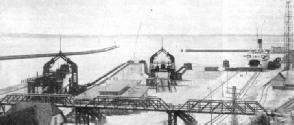
ACROSS THE BALTIC SEA, train ferries link Germany and Sweden. Here is the harbour of Sassnitz on the German side. Trelleborg, the Swedish port, is fifty-
THE chief advantage of a train ferry lies in the fact that it saves any transference of goods. Wagons can be run on to it at one port and off it at the other, so working through from start to finish.
Where fragile goods are concerned all risks of breakage by handling at the ports are avoided. Perishable goods also derive considerable benefit from a train ferry. Greater speed in transit has enabled more business to be done between Continental countries.
Although it is becoming an increasingly vital factor in modern commerce, the train ferry is not a new idea. Long before the Forth Bridge had been built railway wagons were carried across the Firth of Forth from Granton pier at Leith to Burntisland, on the Fife coast, to avoid transhipment of their loads. The same thing happened south of Dundee, where the Firth of Tay was spanned by a ferry from Tayport to Broughty, until the Tay Bridge came into being.
The train ferry system is seen at its best in the Baltic. Denmark consists, in the main, of Jutland, a peninsula physically joined by Schleswig-
A journey from England to Copenhagen by the mail route across the North Sea from Harwich to Esbjerg necessitates a trip on a train ferry. At Esbjerg the traveller enters a through sleeping-
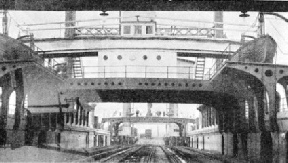
HARWICH-
Next comes a run of fifty-
Finally, a run of sixty-
Similar conditions prevail in approaching Copenhagen from the south. Through sleeping cars are run daily between Berlin, Hamburg and Copenhagen, but there is a wider crossing over the Baltic. The German train brings the passenger as far as Warnemünde, 145 miles north of Berlin on the Baltic coast. From here a large and powerful ferry-
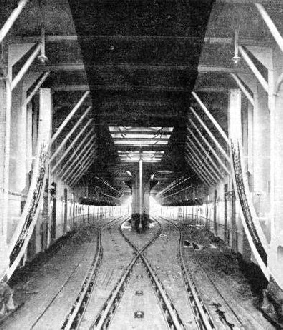
THE CARRIAGE DECK of the German ferry Schwerin, which is one of the ships linking Warnemünde, Germany, with Gjedser, Denmark. The crossing is twenty-
Two hours are needed for the main train ferry crossing, from Warnemünde to Gjedser. Twenty minutes or so can be added for the short crossing and more than an hour for the four movements of the vehicles on and off the ships, so that from reaching Warnemünde to leaving Masnedo, only fifty-
In order to curtail these journeys and speed up these through services, the Danish Government decided to embark on two ambitious projects, the first of which has already materialised. An immense steel bridge has been thrown across the Little Belt, and the trains will be able to run through from Esbjerg, Aarhus and other Jutland towns to Nyborg, so that only the Great Belt crossing by water will remain. By this means it will be possible to accelerate the service by forty minutes.
The famous British firm, Dorman Long, which built the Sydney Harbour Bridge, undertook the bridging of the strait between Orehoved and Masnedo, by an enormous cantilever structure; a splendid work to vie with the biggest bridges in the world. It is a matter of no small pride that this contract was secured in the teeth of strenuous competition from bridge-
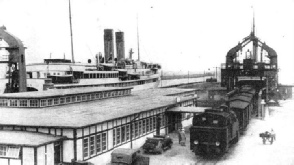 ACROSS THE BALTIC SEA, train ferries link Germany and Sweden. Here is the harbour of Sassnitz on the German side. Trelleborg, the Swedish port, is fifty-
ACROSS THE BALTIC SEA, train ferries link Germany and Sweden. Here is the harbour of Sassnitz on the German side. Trelleborg, the Swedish port, is fifty-
But the longest of all the Baltic train ferry crossings is the direct service between Germany and Sweden, which crosses from Sassnitz, on the German island of Rügen, direct to Trelleborg, near Malmö in Sweden, a distance of fifty-
This service, operating at night, was brought into operation jointly by the German and Swedish Governments, each contributing two vessels to the fleet; the total outlay on the scheme was approximately £1,000,000. The Germans built their own two vessels; of the two Swedish ships, one was built in Sweden and the other in Great Britain.
The Swedish train-
The main deck, entered from the stern, carries two tracks, each 295 ft in length, and is capable of accommodating eight passenger coaches, in two rows of four each. The size of coach permissible may reach a total height of 15¼ ft, with a width of just over 11 ft, which are the maximum dimensions allowed on the railways of Germany and Sweden. A system of trimming tanks on the vessel enables her to accommodate herself to the level of the rails at the terminals, according to the state of the tide.
Weather Precautions
To secure the coaches during their sea journey, heavy shackles are fitted, both inside and outside the track, the former 4 ft 4-
Some passengers, especially those travelling in the sleeping-
Two large searchlights are fitted, one forward and one aft, to assist in berthing the vessel. To facilitate entry into the ferry terminals, there is a bow rudder, in addition to the usual stern rudder; the former is locked by a bolt in the neutral position during the voyage. Accommodation is provided on board for a postal staff, who sort the mails on the steamer, as well as for the customs officials, who also do their work on the trip.
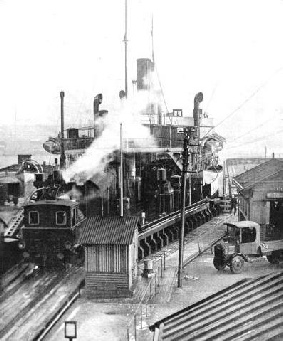
A LINK BETWEEN SWEDEN AND DENMARK. A ferry service operates between Copenhagen and Malmö. Here the train can be seen leaving the ferry after a crossing of one and a half hours. The ferry is provided with a double track, and can handle both goods and passenger traffic. After the coaches are in position the locomotive backs away, and at the other terminal another engine is employed.
Through sleeping-
Another way in which through coaches cross from the German mainland to Sweden is by the Warnemünde-
The total number of train-
During the war it became evident that, if some method could be devised of running munitions and guns across the English Channel without having to load them on and off ships at the Channel ports, a great deal of time and labour would be saved.
The simplest solution was a train ferry; and this led to the establishment of an entirely new port, on an inlet of the Kent coast between Ramsgate and Sandwich, called Richborough. Here a train-
After the war these services, having fulfilled their valuable function, ceased to operate. But it was felt that the principle thus established ought to be perpetuated, and so a company was formed to take over the ferry-
The company began its services in 1924, and took the name of “Great Eastern Train Ferries, Ltd”, owing to the lengthy association of the late Great Eastern Railway and its Continental steamer services with Harwich and the adjacent port at Parkeston Quay. The train ferry service is now worked by the London and North Eastern Railway.
Special wagons have been built for the ferry service. They are easily recognizable, when running on this side of the water, by their inscriptions, in various Continental languages. Rather longer than the average covered wagon in this country, and painted white, they form a prominent object in any freight train in which they may be marshalled.
Each of the ferry-
Notwithstanding the North Sea gales, not a single one of the nightly trips of the Harwich-
Loads of special interest have often crossed by the Harwich-
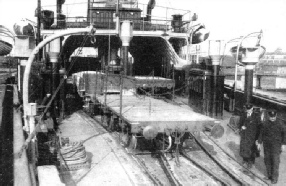
ON THE MALMÖ ROUTE this Danish ferry, the Prins Christian, is used for conveying freight and passengers to Sweden.
The heaviest consignment ever carried by this train-
Communication between the ship and the shore, at the terminals, is made in the customary manner by means of a lifting bridge, which is hinged at the shore end, and coupled at the outward end to the vessel. In this way wagons can be run on and off the ship at all states of the tide. At high tide the vehicles run on an up-
Recent developments enable passenger services across the English Channel by train ferry to be considered. Many years ago there was a strong agitation for a tunnel to be bored under the English Channel, and work was begun on this vast project. The total length of such a tunnel would have been fully twenty-
Various other projects have been devised for bridging the Channel, but the simplest substitute -
Three ferry-
Ice-
One of the most remarkable train-
But during the winter months the crossing is reminiscent of a trip to the Arctic. The strait has become a mass of ice from one side to the other. It is, furthermore, a broken and irregular barrier, in confused masses, for pack ice comes drifting in from the Gull of St. Lawrence, in which there are present huge rugged hummocks of ice, intersected by stretches of open water, and areas of broken ice and water, known as “lolly”, in which navigation requires a good deal of expert knowledge.
For many years communication was maintained by the Government steamers Stanley and Minto, specially designed for icebreaking. Now their place has been taken by the powerful icebreaking train ferry steamer Prince Edward Island, which makes the connexion, twice daily in each direction, between the main system of the Canadian National Railways at Cape Tormentin and the island railways, now also owned by the CNR, at Borden. Through coaches and wagons are run between the island and the mainland.
The Prince Edward Island is 285 ft in length, and has a moulded depth of 32 ft; her dead weight, on a draught of 18 ft, is 650 tons. The vessel is so designed as to offer the least possible resistance when forcing its way through ice; the hull is abnormally strong, and the frames, which are of extra large section, are more closely spaced than usual. For a depth of 6 ft, extending above and below the waterline, the steel plating of the hull is 1-
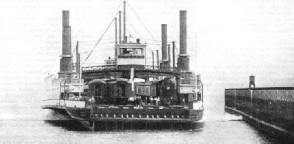
AN AMERICAN TRAIN FERRY on the Southern Pacific Railway system operating across the Strait of Carquinez. The ferry can accommodate eighteen all-
You can read more on
and
and
on this website.
You can read more on
the Southern’s
and on the LNER’s
in Shipping Wonders of the World